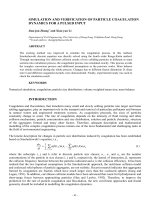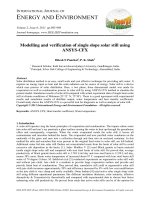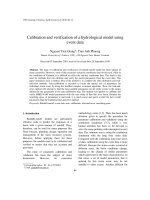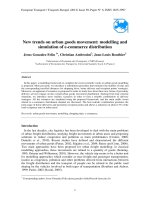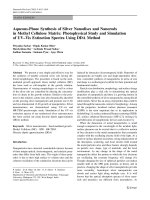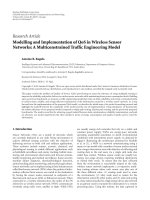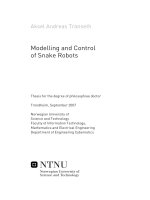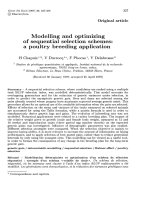Modelling and verification of single slope solar still using ANSYS-CFX
Bạn đang xem bản rút gọn của tài liệu. Xem và tải ngay bản đầy đủ của tài liệu tại đây (479.92 KB, 14 trang )
INTERNATIONAL JOURNAL OF
ENERGY AND ENVIRONMENT
Volume 2, Issue 6, 2011 pp.985-998
Journal homepage: www.IJEE.IEEFoundation.org
Modelling and verification of single slope solar still using
ANSYS-CFX
Hitesh N Panchal1, P. K. Shah2
1
2
Research Scholar, Kadi Sarvavishwavidyalaya University, Gandhinagar, India.
Principal, Silver Oak College of Engineering & Technology, Ahmedabad, India.
Abstract
Solar distillation method is an easy, small scale and cost effective technique for providing safe water. It
requires an energy input as heat and the solar radiation can be source of energy. Solar still is a device
which uses process of solar distillation. Here, a two phase, three dimensional model was made for
evaporation as well as condensation process in solar still by using ANSYS CFX method to simulate the
present model. Simulation results of solar still compared with actual experiment data of single basin solar
still at climate conditions of Mehsana (23°12’ N, 72°30’). There is a good agreement with experimental
results and simulation results of distillate output, water temperature and heat transfer coefficients.
Overall study shows the ANSYS CFX is a powerful tool for diagnostic as well as analysis of solar still.
Copyright © 2011 International Energy and Environment Foundation - All rights reserved.
Keywords: ANSYS CFX; Heat transfer coefficient; Water temperature.
1. Introduction
A solar still operates sing the basic principles of evaporation and condensation. The impure saline water
into solar still and sun’s ray penetrate a glass surface causing the water to heat up through the greenhouse
effect and consequently, evaporate. When the water evaporated inside the solar still, it leaves all
contaminants and microbes behind the basin. The evaporated and now purified water condenses on the
underside of the glass and runs into a collection through and then into an enclosed container. In this
method the salts and microbes that were present in the original feed water to solar still, are left behind.
Additional water fed into solar still flushes out concentrated waste from the basin of solar still to avoid
excessive salt deposition in the basin. [1]. Jadav Madhav V [2] used Black granite as basin material
inside single slope solar still and compared with iron steel basin of solar still. He proved that, average
productivity of black granite basin solar still is 3.784 L/m2.day and iron steel basin is 2.358 L/m2.day,
means 38% more. Basin water temperature of increased about 87 C compared with Iron steel basin still
water of 79 degree Celsius. M. Sakthivel.et.al [3] conducted experiment on regenerative solar still with
and without jute cloth. Jute cloth is a medium to provide large evaporation surface and provide and
provide latent heat of condensation. They proved that, cumulative still yield in regenerative solar still
with jute cloth increases approximately 20% and efficiency increased by 8% with low cost modification
as the jute cloth is very cheap and easily available. Omar badran [4] used active solar single slope solar
still using different operational parameters like different insulation thickness, solar intensity, effective
absorptivity & Transmissivity theoretically and compared with experimental data to choose best factor
enhancing solar still productivity. He proved from study that active solar stills can be of the options for
ISSN 2076-2895 (Print), ISSN 2076-2909 (Online) ©2011 International Energy & Environment Foundation. All rights reserved.
986
International Journal of Energy and Environment (IJEE), Volume 2, Issue 6, 2011, pp.985-998
enhancing productivity of still. Kalidasa Murugavel et.al [5] made a double basin solar still from mild
steel plates and used layer of water as well as different heat storage materials like quartzite rock, red
brick pieces, cement concrete pieces, washed stones and iron scrapes. He found that, still with ¾ size
quartzite rock was effective basin material to increase distillate output among other sensible heat storing
materials. F.F. Tabrizi, A.Z. Sharak [6], used inbuilt sandy heat reservoir experimentally under climate
conditions of Iran. He proved that, integrated sandy heat reservoir increases significantly productivity of
solar still during nights as well as cloudy days conditions, and it does not require any pumping element
as well as operators for night mode usage. K. Kalidasa Murugavel et.al[7] used double slope basin solar
still tested with mild steel plates with minimum mass of water and different wick materials like light
cotton cloth, sponge sheet, waste cotton pieces, coir mate pieces in basin also use aluminum fin arranged
in different configuration. He found that from experiment that, light black cotton cloth is effective wick
material compared with other wick materials as well as aluminum fin covered with cotton cloth and
arranged in length wise was more effective. R.dev et.al [8] used new approach to obtain characteristic
equation of a double slope passive solar still based on experimental observations from composite climate
conditions of New delhi. He concluded that, non linear characteristic curves have more accurate for
analyzing performance, thermal testing and further modification depending on various parameters
associated with design. Climate and operational conditions. R.dev et.al.[9] made a inverted absorber
solar still having curved reflector to heat it from top and bottom with single slope solar still. He used
instantaneous gain and loss efficiencies by experimental data for climate conditions of Muscat, Oman.
He also compared similar operating and climate conditions with single slope solar still and also he found
annually cost of distillate output of Inverted absorber solar still and single slope solar still were 0.95 &
0.54 Rs .A.J.N. Khalifa[10] studied literature on relation between cover tilt angle and productivity of
simple solar stills in various seasons for relation between optimum tilt angle and latitude angle and
concluded that, cove tilt angle should be larger in winter and smaller in summer, increasing tilt angle
would increase productivity and maximum productivity achieved by using cover tilt angle close to the
latitude of place. S.abdullah et.al.[11] made four identical solar stills used various absorbing materials
used in single slope solar still like uncoated and coated porous medium called metallic wiry sponges and
remaining two used black volcanic rocks and without any medium in climate conditions of Jordan. From
experiment, he found that, uncoated sponge has highest water collection during day time followed by
black rocks and coated wiry sponges
Objective of this paper is ANSYS CFX modeling of evaporation and condensation processes that occurs
in solar stills. Water in the system vaporizes by the solar insolation. Temperature difference between
water vapor and glass leads to vapor condensation in glass cover. Droplets slip down and gather on the
distillate channel. For fresh water calculation in simulations, amount of accumulated water on distillate
channel is considered as rate of water production inside solar still. Fresh water production rate and water
temperature from simulation results compared with actual results. And also comparison made with
simulation result and experimental results of water temperature, glass cover temperature, evaporative
heat transfer coefficient and convective heat transfer coefficient.
2. Mathematical modeling
Performance of solar still based on productivity, efficiency as well as internal heat and mass transfer
coefficient. Hence performance directly proportional to internal heat transfer coefficient and distillate
output from solar still. Internal heat and mass transfer coefficient in the solar still based on three
parameters called convection, radiation and evaporation, hence there are three heat transfer coefficient
called convective heat transfer coefficient, radiative heat transfer coefficient and evaporative heat
transfer coefficient.
2.1 Convective heat transfer
Action of buoyancy force due to density difference of humid air due to temperature difference is the
major reason behind the convective heat transfer coefficient in solar still. The convective heat transfer
coefficient of water surface to condensing glass cover is given by:
q cw = hcw (Tw − Tg )
(1)
Heat transfer coefficient hcw can be calculate by following equation
ISSN 2076-2895 (Print), ISSN 2076-2909 (Online) ©2011 International Energy & Environment Foundation. All rights reserved.
International Journal of Energy and Environment (IJEE), Volume 2, Issue 6, 2011, pp.985-998
hcw =
0.884[(Tw − Tg ) + ( Pw − Pg )(Tw + 273)
(268.9 × 10 − Pw )
3
1
3
987
(2)
2.2 Radiative heat transfer
Solar energy is responsible for the formation of pure water from the solar still. Radiative heat transfer is
also responsible through solar energy. Rate of radiative heat transfer from water surface to condensing
cover is given by:
q rw = hrw (Tw − Tg )
(3)
Radiative heat transfer coefficient hrw is given by:
hrw = ε effect σ [(Tw + 273) 2 + (Tg + 273) 2 ]
(4)
Here,
σ = 5.669 × 10 −8 W / m 2 K 4
ε effect = (
1
εg
+
1
εw
− 1) −1
(5)
(6a)
ε g = ε w = 0.9
(6b)
2.3 Evaporative heat transfer
When solar energy is incident inside the solar still, water evaporates and converted into steam. Hence,
evaporative heat transfer is given by following equation
q ew = hew (Tw − Tg )
(7)
Evaporative heat transfer coefficient is given by
hew = 16.27 × 10 −3 × hcw ×
( Pw − Pg )
(Tw − Tg )
(8)
Total heat transfer coefficient from water surface to condensing cover is given by following equation
h1w = hcw + hrw + hew
(9)
2.4 Energy balance
When solar energy is incident inside the basin water, heat transfer mechanism starts. Figure 1. Shows the
energy flow in single slope single basin solar still. Energy balance equation can be written with following
assumption
1. There is no vapor leakage in solar still
2. It is an air tight basin, hence no heat loss.
3. Heat capacity of cover and absorbing material, insulation is negligible.
4. There is no temperature gradient across the basin water and glass cover of solar still.
ISSN 2076-2895 (Print), ISSN 2076-2909 (Online) ©2011 International Energy & Environment Foundation. All rights reserved.
International Journal of Energy and Environment (IJEE), Volume 2, Issue 6, 2011, pp.985-998
988
5. Water level inside the basin maintained at constant level.
6. Only film type condensation is occurs in place of drop type condensation.
•
Energy balance for glass cover
α g ' I (t ) + (q rw + qcw + qew ) = q rg + qeg
•
Energy balance for basin water
α ' b I (t ) + q w = ( MC ) w
•
Tw
+ q rw + qew + qcw
dt
Ass
)
As
η=
(13)
Hourly yield of solar still is given by:
mw =
•
(12)
Heat transfer coefficients
h1g = 5.7 + 3.8V
•
(11)
Energy balance for basin
α b ' I (t ) = q w + (qcb + q s (
ã
(10)
qew
ì 3600
L
(14)
Efficiency of solar still is given by
qew
I (t )
(15)
Figure 1. Energy flow in Single basin single slope solar still
ISSN 2076-2895 (Print), ISSN 2076-2909 (Online) ©2011 International Energy & Environment Foundation. All rights reserved.
International Journal of Energy and Environment (IJEE), Volume 2, Issue 6, 2011, pp.985-998
989
3. Experimental set up
Figure 2 shows experimental set up of single slope solar still. Experimental set up consists of condensing
cover of 30 degree fabricated to accommodate 0.20 m water depth maximum. The bottom surface of the
still was painted black for greater absorptivity. As we know that, output from the still gets maximum
when it consists of least water depth. To avoid spilling of water into distillate channel and to prevent the
contact of distillate channel with flasks cover as well as with water level, height of lower vertical side of
still was kept as 0.30 m, whereas the height of higher vertical side was kept 0.85 m. The effective basin
area of 1 meter x 1 meter made of GRP of 4 m thickness. Condensing cover made of toughed glass of 4
mm is fixed to the top of vertical walls of the stills using a rubber gasket on both sides of glass and clamp
fixed iron frames made of angles. A plastic pipe is connected to thin channel to drain the distillate water
to an external measuring jar. Whole set up of solar still is installed on stand.
Figure 2. Experimental set up of solar still
4. Flow geometry
ANSYS is engineering simulation software, which is widely used in engineering problems. Figure 3
shows 3 dimensional model of solar still based on data available in experimental set up of solar still by
ANSYS 10. Figure 4 shows meshing structure of solar still.
ISSN 2076-2895 (Print), ISSN 2076-2909 (Online) ©2011 International Energy & Environment Foundation. All rights reserved.
990
International Journal of Energy and Environment (IJEE), Volume 2, Issue 6, 2011, pp.985-998
Glass
Distillate
output channel
Figure 3. Model geometry of solar still made in ANSYS Workbench
Figure 4. Meshing of model of Solar still in ANSYS
ISSN 2076-2895 (Print), ISSN 2076-2909 (Online) ©2011 International Energy & Environment Foundation. All rights reserved.
International Journal of Energy and Environment (IJEE), Volume 2, Issue 6, 2011, pp.985-998
991
4.1 Boundary & initial conditions
Continuity equation, momentum equation and boundary conditions must be specified at all the
boundaries in model of solar still in ANSYS. The recorded experimental data are for 8 hours (morning 9
to evening 5). Here Ansys CFX run time of 8 hours that is required for modeling of solar still which is in
an unsteady state process. Hence, to overcome this problem, it assumes that steady state condition is
reached after time period of 1 hour and received water; glass temperatures inside basin are constant.
Here distillate output temperature is assumed equal to glass cover temperature. Solar insolation is based
on absorption factor and emissivity of glass. For producing droplets inside the solar still, it assumes that
adhesion forces are taken into account in simulation. Side walls were assumed as adiabatic wall; hence
no heat losses occur in solar still to ambient. A no-slip wall boundary condition was specified for the
liquid phase and free slip boundary conditions was used for gas phase. Figure 5 shows the non slip
boundary conditions of solar still model. It assumes that, distillate water collected in distillate channel
equal to evaporation takes place inside the solar still. For effective simulation, adiabatic condition is
required, which prevents the heat transfer losses. Hence, there is a good agreement is required between
walls as well as glass, hence between them, no leakage should be occur, hence condition is require in
simulation in ANSYS, hence Figure 6 shows adiabatic condition between glass and walls. It is shown by
Green colour.
Figure 5. No slip wall boundary condition of solar still
ISSN 2076-2895 (Print), ISSN 2076-2909 (Online) ©2011 International Energy & Environment Foundation. All rights reserved.
992
International Journal of Energy and Environment (IJEE), Volume 2, Issue 6, 2011, pp.985-998
Figure 6. Adiabatic condition between glass and wall
Initial water level inside the solar still is assumed as 0.30 meter for simulation purpose. Water and
volume fraction were considered as 0.13 and 0.87 respectively. Initial temperature of water and gas
velocity was used according to experimental data in each hour. Most important factor inside solar still is
application of solar insolation, incident in solar still. First it will incident on glass cover, due to
absorptivity and transmissivity of glass cover, it will absorb by absorber plate and increase temperature
of water. Figure 7 shows application of heat flux (solar insolation) in watt per meter square.
5. Simulation results
Building model geometry and its meshing were done using ANSYS Workbench 10. Unstructed mesh of
type tetrahedron was used. The sensitivity of the simulation result is very important for optimum
analysis, and it can be checked by grid size, hence by checking the results of 32311 47126 64512 and
84121 cells, with increasing numbers of grids, hence simulation result become close to experimental
results.
Figure 8 Shows result of simulation runs and experimental data in a 8 hours time period. In this figure, it
is noted that, as the process begins at 9 am by passing time, water starts warming up due to increase in
solar insolation and formation of vapor as well as distillate water production starts and increases upto 3
pm. After, it decreases gradually due to decrease in solar insolation in sky.
ISSN 2076-2895 (Print), ISSN 2076-2909 (Online) ©2011 International Energy & Environment Foundation. All rights reserved.
International Journal of Energy and Environment (IJEE), Volume 2, Issue 6, 2011, pp.985-998
993
Figure 7. Application of Incident solar insolation applied to glass cover
0.3
0.25
0.2
0.15
0.1
0.05
0
9
10
11
12
13
14
15
16
17
Fresh water produced by ANSYS CFX Simulation Data
Fresh Water Produced by Experimental Data
Figure 8. Rate of water production from experimental data and simulation results
Water temperatures predicted by ANSYS CFX simulation are compared with experimental data is as
shown in Figure 8. It shows that, water temperature increases upto 3 pm, due to good availability of heat
energy in solar insolation, and after 3 pm, decreases gradually. Here there is some difference between
available experimental result and simulation result, Difference between available experimental result
ISSN 2076-2895 (Print), ISSN 2076-2909 (Online) ©2011 International Energy & Environment Foundation. All rights reserved.
994
International Journal of Energy and Environment (IJEE), Volume 2, Issue 6, 2011, pp.985-998
and simulation result is called “ Error”, hence From Figure 8 and Figure 9, it shows that the average
errors for production rate and water temperature are 6.0% as well as 10.25% respectively.
80
60
40
20
0
9
10
11
12
13
14
15
16
17
Water Temperature by ANSYS CFX Simulation data
Water Temperature by experimental Data
Figure 9. Water temperature predicted by ANSYS CFD Simulation and experimental data
70
60
50
40
30
20
10
0
9
10
11
12
13
14
15
16
17
Glass Cover Temperature by ANSYS CFX Simulation data
Glass cover Temperature by Experimental Data
Figure 10. Glass cover Temperature predicted by ANSYS CFX Simulation result and experimental data
In solar still, after evaporation, condensation process starts, and condensation produced by inner glass
cover, and difference of temperature of water and glass cover defines performance of solar still.
Experiments shows that, higher temperature difference of water and glass cover temperature, higher
distillate output and reverse cause the decrease in distillate output from solar still (Figure 10).
Figure 11 shows simulation result of various temperatures measured by probe put in solar still model
called temperature contour. In solar still, temperature plays vital role for optimum analysis of solar still,
hence temperature variation is very crucial and it is shown by showing colours in model. Figure 12
shows side view of temperature contour.
ISSN 2076-2895 (Print), ISSN 2076-2909 (Online) ©2011 International Energy & Environment Foundation. All rights reserved.
International Journal of Energy and Environment (IJEE), Volume 2, Issue 6, 2011, pp.985-998
995
Figure 11. Temperature contour various points in solar still
Figure 12. Side view of Temperature contour of solar still
ISSN 2076-2895 (Print), ISSN 2076-2909 (Online) ©2011 International Energy & Environment Foundation. All rights reserved.
996
International Journal of Energy and Environment (IJEE), Volume 2, Issue 6, 2011, pp.985-998
As we know that, heat transfer is only phenomena require for producing distillate output from solar still.
It is due to buoyancy force and it is produced by density difference in the gas phase. Density difference
also occurs because of temperature difference in the mixture. Therefore gas phase gets a motion in solar
still and heat transfer takes place due to natural convection process. Figure 13 and Figure 14 shows the
variation of evaporative as well as convective heat transfer coefficient from experimental result and
ANSYS CFX simulation results.
7
6
5
4
3
2
1
0
9
10
11
12
13
14
15
16
17
Variation of Convective heat transfer coefficient by ANSYS CFX
Simulation Data
Variation of Convective heat transfer coefficient by experimental
Data
Figure 13. Side view of temperature contour of solar still
50
40
30
20
10
0
9
10
11
12
13
14
15
16
17
Variation of evaporative heat transfer coefficient with ANSYS CFX
Simulation data
Variation of Evaporative Heat transfer coefficient with experimental
data
Figure 14. Side view of temperature contour of solar still
6. Conclusion
Here, evaporation and condensation processes are occurring in solar stills were simulated by ANSYS
CFX. A two phase, three dimensional model were developed and simulation continue upto 8 hours
continuously as 8 steps of 1 hour period. There are good correlations or agreements between simulated
results as well as experimental results of Distilled water rate, Water temperature, glass cover
temperature, convective heat transfer coefficient and evaporative heat transfer coefficient. Predicted
results by ANSYS CFX show that, it is very powerful tool for design, parameter analysis and difficulty
removal in solar still construction.
ISSN 2076-2895 (Print), ISSN 2076-2909 (Online) ©2011 International Energy & Environment Foundation. All rights reserved.
International Journal of Energy and Environment (IJEE), Volume 2, Issue 6, 2011, pp.985-998
997
Nomenclature
Area of cover, m2
Ac
Area of basin liner, m2
As
Area of solar still sides, m2
Ass
Convective heat transfer coefficient from water to cover, W/ m2 /C
hcw
Convective heat transfer coefficient from basin liner to water, W/ m2 /C
hw
Convective heat transfer coefficient from bottom insulation to ambient, W/ m2 /C
hcb
Radiative heat transfer coefficient from bottom insulation to ambient, W/ m2 /C
hrb
Radiative heat transfer coefficient from water to cover, m2 /C
hrw
Evaporative heat transfer coefficient from water to cover, m2 /C
hew
h1w
Total heat transfer coefficient from water to cover, m2 /C
h1g
Total heat transfer coefficient from cover to atmosphere, m2 /C
I(t)
Total solar radiation W /m2
Thermal conductivity of insulating material, W/m/C
Ki
Latent heat of vaporization J/kg
L
Thickness of insulation m
Li
(MC)w
Heat capacity of water mass in basin, J/m2 /C
Distillate output from still L/m2/day
Mew
Partial pressure at cover temperature N/m2
Pg
Partial pressure at basin water temperature N/m2
Pw
Convective heat transfer from water to cover W/m2
qcw
Radiative heat transfer from water to cover W/ m2
qrw
Evaporative heat transfer from water to cover W/ m2
qew
qloss
Overall heat loss from water surface to ambient through top and bottom W/ m2
Heat transfer from base to ambient by conduction W/m2
qcb
Side heat loss to ambient by conduction W/ m2
qs
Convective heat loss from cover to ambient W/ m2
qcg
Radiative heat loss from cover to ambient W/ m2
qrg
Ambient temperature C
Ta
Cover temperature C
Tg
Basin water temperature C
Tw
Greek
α’g
α’w
α’b
geff
gg
gw
σ
ηi
Solar flux absorbed by cover
Solar flux absorbed by basin water
Solar flux absorbed by basin
Effective emissivity, dimensionless
Emissivity of cover, dimensionless
Emissivity of water , dimensionless
Stefan-Boltzmann constant
Instantaneous efficiency, %
References
[1] G N Tiwari, A K Tiwari, “ Solar distillation practice for water Desalination Systems”, Anamaya
publication, pp. 1-10.
[2] Jadav Madhav, “ Performance of black granite basin solar still”, International Journal of Tech
Science, Vol.2 (2), 2011, pp. 161-168.
[3] M. shakthiwel, S. Shanmugasundaram, T. Alwarsamy, “ An experimental study on a regenerative
solar still with energy storage medium-Jute Cloth”, Desalination 264(2010) pp. 24-31.
[4] Omar Badran, “ Theoretical analysis of solar distillation using Active solar still”, International
Journal of thermal & environment engineering, Vol.3 No.2, 2011, pp 113-120.
[5] K. Kalidasa Murugavel, S Sivakumar, J Riaz Ahmed, Kn K S K Chockalingam, K Srithar, “ Single
basin double slope solar still with minimum basin depth and energy storing materials”, Applied
Energy, 87 (2010) 514-523.
[6] Farshad Farshchi Tabrizi, Ashkan Zolfaghari Sharak, “ Experimental study of integrated basin
solar still with sandy heat reservoir,”, Desalination 253 (2010) 195-199.
ISSN 2076-2895 (Print), ISSN 2076-2909 (Online) ©2011 International Energy & Environment Foundation. All rights reserved.
998
International Journal of Energy and Environment (IJEE), Volume 2, Issue 6, 2011, pp.985-998
[7]
K. Kalidasa Murugavel, K Shrithar, “ Performance study on basin type double slope solar still with
different wick materials and minimum mass of water”, International Journal of renewable energy,
Vol. 36, 2011 pp. 612-620.
[8] Rahul dev, G N Tiwari, “ Characteristic equation of the inverted absorber solar still”, Desalination
269 (2011) 67-77.
[9] Rahul dev, H N Singh, G N Tiwari, “ Characteristic equation of double slope passive solar still”,
Desalination 267(2011) 261 – 266.
[10] Abdul Jabbar N Khalifa, “ On the effect of cover tilt angle of the simple solar still on its
productivity in different seasons and latitudes”, Energy conversion and management, 52 (2011)
431-436.
[11] Salah Abdallah, Mazen M. Abu-Khader, Omar Badran, “ Effect of various absorbing materials on
the thermal performance of solar stills”, Desalination 242 (2009) 128-137.
Hitesh N Panchal, received Bachelor and Master from Govt. Engg. College, Modasa and L D College of
Engineering, Gujarat in 2004 and 2006 respectively. His Ph.D. is pursuing in Solar Thermal Engineering
from KSV University, Gandhinagar, Gujarat under guidance of Dr. P. K. Shah. He is an Assistant
Professor in the Department of Mechanical Engineering, L C Institute of Technology, Mehsana He has
Presented 14 Research Papers in International Conferences and 22 Research Papers in National
Conferences. He has Published 13 Research Papers in Reputed International Journals having a good impact
factor. He is also a reviewer of 7 International Journals having high repute. His areas of interests are
Internal Combustion Engine, Automobile Engineering, and Solar Thermal Engineering Etc. He is a
member of ISTE, ISME, SOPTER, SESI etc.
E-mail address:
P. K. Shah did his Graduation and Post-Graduation in Mechanical Engineering from Gujarat University.
He obtained his Ph. D. in Solar Heat Transfer from North Gujarat Uni. He has teaching experience of 39
years in various Engineering Colleges in Gujarat. He is a popular teacher among the students. He has
written number of technical research papers and has presented them in National and International
Conferences. He has published 20 Research Papers in reputed International and National Journals. He has
written many scientific and general articles in various magazines. He also has written a text book on
Thermodynamics for Engineering students. The subjects of his interest are Heat and mass Transfer and
Energy Sources. Presently, he is working as Principal in Silver Oak College of Engineering and
Technology, Ahmedabad.
E-mail address:
ISSN 2076-2895 (Print), ISSN 2076-2909 (Online) ©2011 International Energy & Environment Foundation. All rights reserved.
